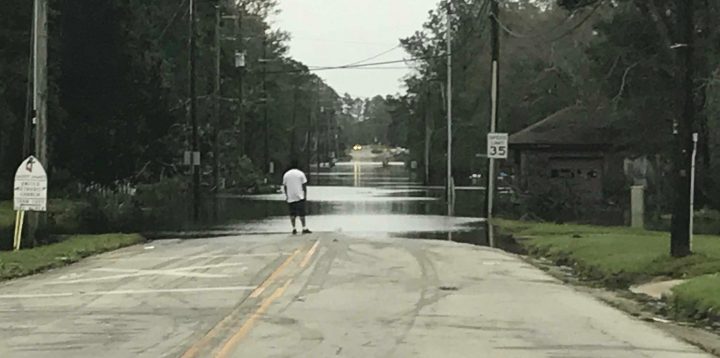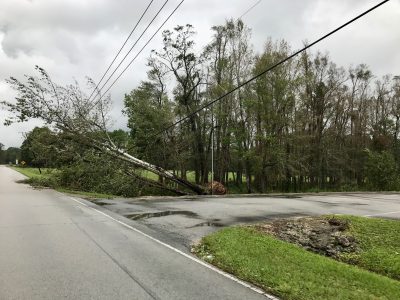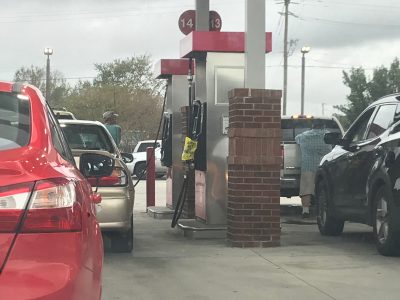
NEWPORT – We’re trying. As this Carteret County community struggles to get back to normal we’ve been trying to get a report on conditions here posted at Coastal Review Online. Wednesday was our first opportunity to publish.
Power has been restored to more and more homes and businesses each day since Florence moved on, mobile phones work in some places some of the time, but internet service has proved elusive until now.
Sponsor Spotlight
Florence left a large swath of damage and destruction, but residents here have begun putting the pieces back together. It’s going to take a while. Each day, we hear about more who lost everything. The extent of the destruction is just becoming clear for those of us left isolated by the storm.

Like most lifelong coastal North Carolina residents, I’ve lived through many hurricanes. But unlike some, this is the first disaster I’ve experienced firsthand. For days, news and information have been courtesy a barely web-connected radio station or two, leaving us essentially cut off from the rest of the world. That’s just how it felt.
Saturday morning, the Newport River rose above the bridges and into neighborhoods, leaving Newport temporarily isolated from the rest of Carteret County. Much of the Down East community, we’d heard, was underwater and things weren’t much better to the west, especially in New Bern.
What we’ve heard most has been the obnoxious but welcome roar of generators that for days have kept folks going with some level of comfort – charging mostly useless mobile phones and preserving what little food remains in refrigerators. Conversations, both in person and by phone, are best had a few yards away from the din. Gas stations began making scarce supplies available Sunday, but lines for gas were long and at first and $30 was each customer’s limit. Gas has become more easily available as power is gradually restored across the area.
Sponsor Spotlight
Recovery began at daybreak Friday, even as Florence continued to thrash the coast. Sunrise revealed broken or toppled trees had penetrated homes, mangled trucks and cars and stretched or snapped power lines every so many doors up and down each street. Near the Newport River, floodwaters had trapped some on the highway, who apparently abandoned their vehicles and found safety, and reached the doorknobs or higher in homes. Many homes were lost entirely.

Phone calls only occasionally connect. In Newport, connections are sometimes better if you walk out to the street and pace back and forth until you find a sweet spot. Sending text messages has been like throwing electronic darts that lack feathers. Few reach their targets. Receiving them sometimes happens in spurts, like around midnight when you’ve finally managed to drift off despite the uncomfortably muggy stillness and then your phone starts dinging like a pinball machine. Internet and email? Forget about it. Hence the missed publication schedule for Coastal Review Online.
During the storm, mobile phones became a chorus of emergency warnings directing us to “check local media” for details on tornadoes, flash floods and other calamities. But at the height of the storm, much of the local media were like Coastal Review Online and much of the public, off the grid. This is a big flaw in the public warning system, one that should be addressed before the next storm. Details should accompany alerts. Referrals are not so helpful.
What appears to have worked was the early-warning sounded in the days before Florence arrived.
Forecasters warned of relentless rainfall, dangerous storm surge and flooding at levels most coastal residents had never seen – and even the old-timers were unlikely to have experienced – and wind speed estimates that prompted visions of exploding structures and airborne roofs.
The apparent weakening that followed initial reports gave some hope for the typical, less destructive reality that followed the early alarming forecasts of countless previous hurricanes. But Florence wasn’t like previous storms.
Making landfall as a Category 1, Florence didn’t really “weaken.” The storm instead shifted into low gear, grinding to a near halt to slowly pummel the barrier islands along Onslow Bay, drenching nearly all of eastern North Carolina with driving and persistent rains and forcing a massive wall of water into inland communities along sounds and rivers.

Following the storm, curfews were enacted or extended to deter criminal or just plain stupid activities. But storm-related incidents appear to have been few and mostly unrelated to bad behavior, despite a fistfight in a local grocery store parking lot Sunday morning.
Mostly there have been examples of shining humanity.
Large convoys of bucket trucks operated by local line crews and volunteers from distant towns arrived to help restore desperately needed power as quickly as possible. Fire crews from all over the state brought their various types of apparatus to assist. The National Guard showed up, letting anyone in doubt know this really is serious.
Nonprofit groups, loosely affiliated volunteers and others arrived quickly and provided meals, shelter, cleanup help and comfort to those in need. Neighbors combined what they had on hand and fed one another.
People with chainsaws headed out in the early light and continued wind-driven rain Friday and cleared the streets around Newport of fallen trees. Entire crews, some with heavy equipment, went door-to-door to help those with trees on their homes or blocking their driveways. Neighbors helping neighbors, it was going on almost everywhere you looked.
Florence was not quite the same as any of the historic storms we remember, but Florence was what many had warned: the storm of a lifetime. But that’s an assessment that relies only on what we’d seen in the past. Science says we’ll continue to see more like Florence, more often.
We have work to do.







